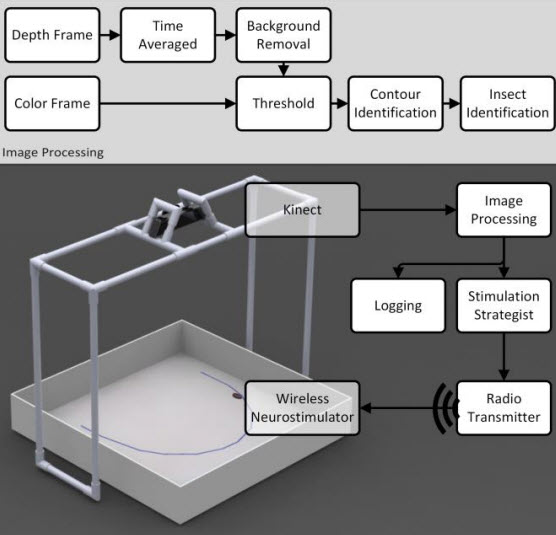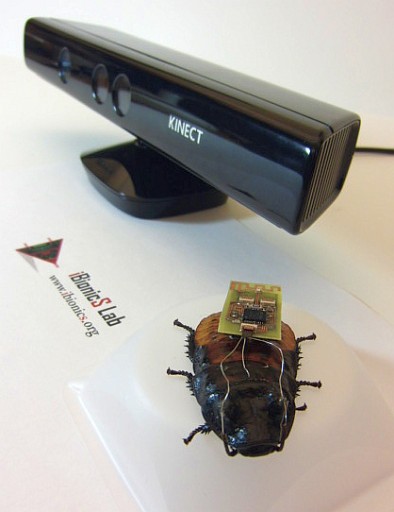Kinect tracks bionic rescue roaches
June 27, 2013 by Amara D. Angelica
When we last visited our “RoboRoach” bionic cockroach, it was being remotely controlled by a mobile phone that triggered hallucinations of an invisible wall (for educational purposes only, mind you).
Seriously.
Now Dr. Alper Bozkurt, an assistant professor of electrical and computer engineering at North Carolina State University, and his team want to take it a step further. They plan to use their Madagascar hissing roaches (dubbed “biobots”) on autopilot to map dynamic environments, such as collapsed buildings.
Minority Report scenario
As we noted in September: funded by the National Science Foundation, these researchers plan to create “a mobile web of smart sensors that uses cockroaches to collect and transmit information, such as finding survivors in a building that’s been destroyed by an earthquake.”
As a first step, they embedded a lightweight chip and a WiFi wireless receiver/transmitter onto the roach to precisely steer the roach’s movement (forward/reverse, left/right) along a curved line (see video below).

Kinect-based roach monitor/controller (credit: Alper Bozkurt/NC State University)
Now, to speed things up in this test phase, they are using a motion-sensing Microsoft Kinect, which can visually track the roach and send signals wirelessly to a neurostimulator connected to the roach to remotely steer it.
“ATTENTION: we are biobot roaches and we’re here to help you! We don’t want your food, really!”
When deployed, the roaches would also be equipped with sensors, such as microphones, to detect survivors in collapsed buildings or other disaster areas.
“We may even be able to attach small speakers, which would allow rescuers to communicate with anyone who is trapped,” Bozkurt says.
The interface that controls the roach is wired to the roach’s antennae and cerci.
Components of radio transmission between Kinect/PC (top) and stimulation circuitry on insect (bottom)(credit: Alper Bozkurt/NC State University)
The cerci are sensory organs on the roach’s abdomen, which are normally used to detect movement in the air that could indicate a predator is approaching – causing the roach to scurry away.
But the researchers use the wires attached to the cerci to spur the roach into motion.
The wires attached to the antennae send small charges that trick the roach into thinking the antennae are in contact with a barrier and steering them in the opposite direction.
“911, what’s your emergency?
“Help, I’m trapped under Costco and I’m being attacked by remote-controlled talking cockroaches with computer backpacks!”
“Stay calm. We’re sending our best psychiatrist.”
